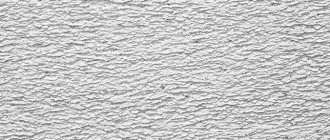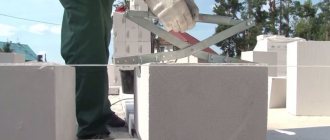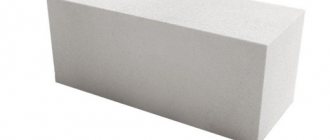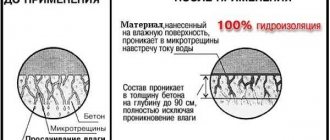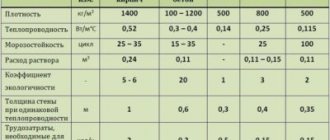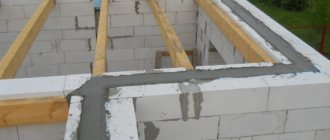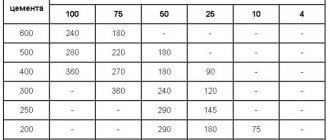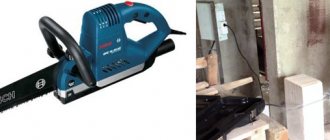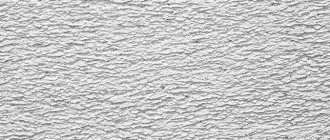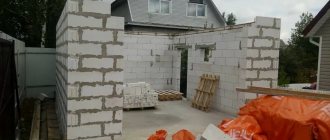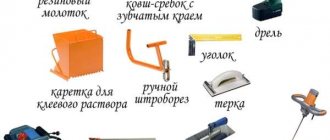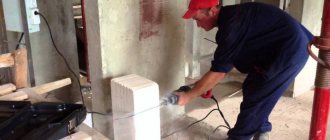In our country, they began to actively build from aerated blocks in the 1950s. In the mid-2000s, technology experienced its rebirth. Since then, gas block has become one of the most popular masonry materials, second in popularity only to brick and foam block. The advantages of aerated concrete blocks are obvious - large format (faster and easier masonry), flat surface (cheaper external and internal finishing), excellent thermal insulation properties (saving on heating) and ease of installation (saving on builders).
There is also nothing complicated in the production of aerated blocks: you need water, lime, cement, quartz sand and a suspension of aluminum powder. The powder reacts with lime, releasing a large amount of gas. This is how air pores (bubbles) appear in the cement-sand mixture, which occupy about 85% of the volume of the block. Swelling and setting of the solution occurs in special vibrating containers. After waiting for the pre-hardening stage, irregularities are removed from the surface of the aerated concrete, and the remaining mass is cut into blocks of equal size. The resulting workpieces undergo high-temperature steam treatment in an autoclave, after which they are calibrated using milling equipment. If previously only large enterprises could produce gas blocks, now for relatively little money, from 300 to 500 thousand rubles. Anyone can buy a small line for making aerated concrete in artisanal conditions.
Due to the availability of technology, factories and small companies producing autoclaved cellular concrete (which is what aerated concrete is made of) have spread throughout the country. The supply of aerated concrete has increased, prices have fallen. Compared to the mid-2000s, gas blocks have become considerably cheaper. However, there are always companies that want to earn more money for the same product. The Xella company, which produces YTONG® aerated concrete blocks, is just such a case.
there is nothing reprehensible in trying to sell your products at a higher price , this is how the world works. Hundai sells its cars for hundreds of thousands of rubles, and Rolls-Royse for tens of millions, but we understand perfectly well what causes the difference. In the case of aerated blocks, wall building materials made from ordinary water, lime, sand and cement, everything is not so simple.
Here is a table to compare the prices of YTONG® blocks with the prices of other popular brands of blocks. The difference in price per cubic meter is almost 20%.
| Manufacturer | YTONG® | INSI | Teplit | Porablock | Revit |
| Economy segment | |||||
| Block brand | Economy D500/300 | Wall block | Twinblock TB 300-5 | Aerated concrete block | BP-300 D500 |
| Dimensions | 625-300-250 | 625-300-250 | 625-300-250 | 625-300-250 | 625-300-250 |
| Density | 500 | 500 | 500 | 500 | 500 |
| Strength class | 3,5 | 3,5 | 2,5-3,5 | Well | 2,5 |
| Price, ₽/cub. m | 4600 | 3600 | 3600 | 3300 | 3600 |
| Middle segment | |||||
| Block brand | Standard D500/375 | Wall block | TB 400-5 | Aerated concrete block | BP-400 D500 |
| Dimensions | 625-375-250 | 625-400-250 | 625-400-250 | 625-400-250 | 625-400-250 |
| Density | 500 | 500 | 500 | 500 | 500 |
| Strength class | 3,5 | 3,5 | 2,5-3,5 | Well | 2,5 |
| Price, ₽/cub. m | 4600 | 3600 | 3600 | 3300 | 3600 |
| Premium segment | |||||
| Block brand | Hard D600/250 | Wall block | TB 300-6 | Aerated concrete block | BP-300 D600 |
| Dimensions | 625-250-250 | 625-250-250 | 625-300-250 | 625-300-250 | 625-300-250 |
| Density | 600 | 600 | 600 | 600 | 600 |
| Strength class | 5 | 3,5 | 3,5-5,0 | Well | 2,5 |
| Price, ₽/cub. m | 4900 | 3650 | 3800 | 3400 | 3700 |
Considering that more than one or two cubes will go into a house, we assessed the scale of the overpayment for a batch of gas blocks for the construction of such a compact house with an area of 76 square meters. m.
Project of a one-story house made of gas blocks. Area 76 sq. m
The perimeter of the house is 43.32 m, the height of the walls in the corners is 3 m, the masonry area is 129.96 m, the masonry is half a block. To build walls (excluding windows and doors for ease of calculation), you will need 760 blocks, which will be 44.53 cubic meters. m. We will “buy” blocks of the middle price segment.
| Cost of blocks for building a house | ||||
| YTONG® blocks | INSI | Teplit | Porablock | Revit |
| 204838₽ | 160308₽ | 160308₽ | 146949₽ | 160308₽ |
As you can see, the difference is very, very noticeable. And quite rightly, two questions arise:
What do YTONG® blocks have that blocks from other manufacturers don’t? What is the reason for the almost 20% difference in cost?
To answer these questions, we carefully studied the website of the Russian representative office of the manufacturer of YTONG® blocks, comparing the declared characteristics and advantages with data on aerated concrete of other brands.
Aerated concrete blocks grade D500
Aerated concrete blocks of the D500 brand are made from cement, quartz sand with the addition of lime and water.
The creation of high-quality blocks that meet the specifications is only possible in a factory environment. First, cement, ground quartz sand, lime and water are mixed in a special mixer, then aluminum paste is added in the required volume (it is responsible for the appearance of pores in the structure of the material). In a humid, warm chamber, the solution increases in volume due to the formation of a large number of pores and gains its initial strength. Next, the frozen mass is transported to cutting equipment, and blocks with ideal geometry are formed. The material gains final strength in an autoclave oven, where it is exposed to high water vapor pressure and temperatures in the region of +175-200 degrees.
Thanks to the use of high temperature in production, it is possible to obtain high-quality and durable gas blocks, ensuring that they will demonstrate all the declared characteristics.
Where to buy, rent, lease, re-equip, repair, purchase spare parts
It is possible to obtain other information of interest on the websites of companies that specialize in the sale, rental, leasing, re-equipment, maintenance and repair of Yutong buses. In addition, some enterprises also sell spare parts: seats, windshields, batteries and other popular components.
YUTONG, Small class buses, Large buses, High floor buses, City buses, Rear engine, Intercity buses, Low floor buses, Single buses, Front engine buses, Apron buses, One and a half decker buses, Suburban buses, Ritual buses, Sleeper buses, Special buses, Medium buses, Tourist buses buses, Bus characteristics, School buses, Excursion buses
Kinds
There are two types:
- with a smooth surface;
- with tongue and groove.
The former are used for internal and external walls, stairs, partitions, lintels and ceilings in residential buildings and industrial buildings, as well as in restoration work. It has strict geometric dimensions and a uniform surface. It is an excellent platform for gluing wallpaper or laying any other finishing material.
Ytong brand aerated concrete block with tongue and groove is used for the same purposes as a smooth one, but has more advantages:
- thanks to the tongue-and-groove design, it is possible to connect elements without using glue, thereby reducing construction time;
- The u-shape ensures a tight fit, thereby reducing heat loss;
- can perform the function of formwork in the manufacture of stiffeners and reinforced lintels.
Maybe it's all about the environment?
Last but not least, the parameter of YTONG blocks is environmental safety. YTONG blocks are awarded the Ecomaterial Absolute certificate, confirming that the products have passed voluntary certification. From the explanations of the organization that issued the certificate, it follows that “the product meets the standards, the release of harmful substances and toxicity is at least 40% below the maximum permissible concentration, and the production of products uses advanced technologies and equipment that minimizes the impact on the environment,” i.e. . The certificate is partly issued in recognition of the environmental safety of the product, and partly for the safety of the production processes through which the product was produced.
Among the blocks we are considering, only YTONG and Porevit products have an Ecomaterial project certificate. Porevit blocks are assigned the rating value Ecomaterial Green (the material is safe for humans and the environment), which is lower than Ecomaterial Absolute (environmentally friendly material). Teplit blocks have a certificate of conformity of manufactured materials and products to the category of environmentally friendly “green” building materials from the Union of Construction Industry Enterprises of the Sverdlovsk Region.
Since each certification company is guided by its own standards and criteria, for a more adequate comparison of the blocks under consideration, we will compare them in terms of the specific effective activity of natural radionuclides (NER) or natural radiation. Since the level of natural radiation can negatively affect human health, sanitary and epidemiological surveillance services very carefully determine it for all construction products entering the market.
| Norm | YTONG | INSI | Teplit | Porablock | Revit |
| NRN activity indicator, Bq/kg | 370 | 199,3 | 77,5 | s/n | 39,77 |
s/n – corresponds to the norm, the exact value is not indicated.
In the battle for the environment, YTONG blocks have perhaps the worst indicators in terms of natural radiation. However, they are still much safer than the standards require, and therefore can be used to build walls even in children's institutions.
Who is the manufacturer, where is it collected, country, whose production and more
Zhengzhou Yutong Group Co., Ltd. - a company that is a large manufacturer of commercial vehicles: buses and electric buses - under the Yutong brand. The headquarters is located in Zhengzhou City, Henan Province , People's Republic of China. The company has several production bases , pays increased attention to new developments, and part of the annual profit (about 4%) goes to invest in research into advanced technologies . The methods used at the plant are recognized at the highest level.
Yutong U12 city bus. Yutong Photos
The production process is structured in such a way that the time spent on manufacturing each model is minimal, and specialists can quickly adapt any sample to the needs of clients from China, Europe, and Russia.
The company's success is also due to the competent location of logistics workshops, rational planning, high technology, maximum efficiency of production facilities, excellent pricing policy and promotion strategy. The combination of these parameters allows the company to develop and produce buses that have all the positive characteristics necessary to meet the needs of customers.
Which wall design is optimal in terms of cost and risk minimization?
Despite claims that a gas block does not need insulation, residential buildings are usually made with a layer of thermal insulation, on which a facing layer is attached on top. This option makes it possible to save on heating in the future and be confident in the strength and reliability of the building, which will not be destroyed by moisture. The most popular insulation options are mineral wool and expanded polystyrene.
Insulation with mineral wool
Mineral wool is a fibrous insulation material of inorganic origin. The material is made from various rocks, binders and glass. Thanks to the fibrous structure of the wool, air is retained in the thickness and thus insulates the room from the cold, acting as a high-quality and relatively inexpensive insulation.
The main advantages of mineral wool as insulation:
Long service life - 25-40 years. Environmentally friendly and safe for human health due to the absence of dangerous synthetic components in the material. Non-flammability and lack of smoke formation under open fire, which is extremely important for residential buildings.
Low level of hydrophobicity - cotton wool does not absorb moisture at all, but carries it out. Chemical and biological resistance, inertness. Low level of deformation - the insulation does not lose its original shape over time. Good vapor permeability (which is important for aerated block walls, which cannot be finished with impermeable materials, thereby causing moisture retention inside). Its versatility as an insulating material not only retains heat, but also prevents sounds from passing through.
Mineral wool has been used for insulation for a long time and has managed to establish itself as an excellent material that fully copes with its tasks, is inexpensive and easy to install.
What is the best way to insulate aerated concrete walls:
- D300 (wall thickness 20 centimeters) and mineral wool 5 centimeters thick.
- D400 (20 centimeters) and mineral wool 10 centimeters.
- D400 (30 centimeters) and mineral wool 5 centimeters.
- D500 (20 centimeters) and mineral wool 15 centimeters.
- D500 (30 centimeters) and mineral wool 10 centimeters.
- D500 (40 centimeters) and mineral wool in a layer 5 centimeters thick.
These are options that are relevant for central Russia. For the southern regions the values are lower, for the northern regions they are higher.
Insulation with polystyrene foam
Extruded foamed polystyrene (also known as expanded polystyrene) is supplied in the format of slabs made of a dense cellular structure material with a closed pore type. This gives polystyrene strength and the ability to withstand moisture. The material is usually used to insulate foundations, roofs, and basements, but it is better not to line the outside with this heat insulator, as it will cause moisture accumulation.
Despite the characteristics of the material, it is still used for aerated concrete due to such advantages as durability, non-flammability, high heat-saving characteristics, the ability to move the dew point outside the walls, simplicity and ease of installation, and low cost. You can insulate aerated concrete walls with expanded polystyrene with your own hands: installation involves calculations, purchasing sheets, cutting them and fastening them with self-tapping screws.
The thickness of expanded polystyrene is 2-10 centimeters; if necessary, sheets can be doubled. You can also order panels of the required thickness at the factory on an individual basis. For brand D500 with a thickness of 30 centimeters, sheets 10 centimeters thick are sufficient: the insulation will provide all the necessary thermal insulation indicators.
Popular models
The Yutong brand is known in Russia for its comfortable “Tourist” buses. Therefore, when mentioning popular models, the machines for this purpose should be listed: ZK6122H9; ZK6129H; ZK6899HA; ZK6128H; ZK6121HQ; ZK6938HB9; ZK6122HL; ZK6932D1; T122HDH; ZK6752DFA9; ZK6125D1; T13.
Tourist bus Yutong T13. Yutong Photos
A significant part of the assortment consists of urban models, characterized by large capacity; the most popular are ZK6737D; ZK6852HG; U12; ZK6108HGH.
Varieties
Today the Ytong company produces two types of gas blocks:
- smooth;
- tongue-and-groove.
Tongue-crested
Such blocks are used for external and internal decoration (for partitions, walls, lintels, ceilings, restoration work). Using a tongue-and-groove design, you can easily connect all the parts together without using adhesives.
This type of material has a U-shape. It provides the tightest connection, resulting in significantly reduced heat loss. Often this variety is used as formwork during the manufacture of reinforced lintels and stiffeners.
The tongue-and-groove blocks include the D400 model (its dimensions can be 375x250x625, 300x250x625 mm). As a rule, it is used for finishing external walls without insulation. The density of this variety is 400 kg/m3. Vapor permeability is 0.23, and frost resistance is 35.
Smooth
Such blocks, like the previous ones, can be used for a variety of purposes (exterior and interior decoration, construction of partitions, ceilings, stairs, walls). They have strict geometric shapes and a uniform surface. Also, this material often acts as a starting point for laying finishing coatings and wallpapering.
The smooth variety of Ytong aerated concrete includes the D400 model, the size of which can be 150x250x625, 200x250x625, 240x250x625, 250x250x625, 300x250x625, 375x250x625, 400x250x625, 500x250x 625 mm. The density of such building gas blocks reaches 400 kg/m3. Their technical characteristics are the same as those of the D400 material with tongue and groove (vapor permeability is 0.23, frost resistance is 35).
This type of material also includes samples D500 with dimensions 625x250x100, 75x250x625, 50x250x625, 100x250x625 mm (blocks 625x250x100 mm are most often used for the construction of partitions). The density of such material reaches 500 kg/m3. All technical characteristics are the same as those of the D500 tongue-and-groove models.
Ytong also produces reinforced aerated concrete lintels, which provide excellent thermal insulation even in the absence of an additional layer of insulation. For load-bearing internal and external walls, as a rule, they take the PN250 model with a height of 249 mm or PN 125, the height of which is 24 mm. For internal non-load-bearing walls, PP250 with a height of 49 mm is used. This manufacturer also produces prefabricated monolithic floors. They consist of beams with free reinforcement. Such elements are made from reinforced concrete or steel. The length of the parts is determined depending on the spans to be covered. The other component is the T-blocks, which look like inserts sandwiched between two side slots. They rest on beams
The Ytong company also creates arc-shaped aerated concrete blocks. With their help, you can bring your wildest design ideas to life. They make it easy to make semicircular interior partitions. Such elements are installed on thin-seam mortar from the same manufacturer.
Advantages of Chinese models
- Safety. Yutong is the first company to use crash testing to test finished models. In addition, the manufacturer carries out other types of testing both of the entire structure as a whole and of individual elements: chassis, control mechanism.
- Low cost in comparison with European analogues. Yutong buses have an optimal price-quality ratio.
Tourist bus Yutong ZK6938HB9. Yutong Photos
- Good technical characteristics, reliability and high quality , achieved by equipping the machines with modern components, mechanisms and units from leading enterprises in Europe and the USA. MAN specialists worked on the design, Cummins engines were made in the UK or China, gearbox from Allison, shock absorbers from Sachs brand.
- Compliance with modern environmental safety requirements.
- Modern, interesting design of the body and interior of vehicles.
- Economical fuel consumption of both diesel and gas engines.
- Meeting the high standards of passenger and driver comfort.
- A wide variety of models differing in purpose and capacity class.
- Low cost of maintenance/operation, availability of spare parts and components.
Owner reviews
Owners and drivers note not only positive, but also some negative parameters of the equipment:
- Difficult passage between seats;
- inconvenient interior layout;
- intermittent problems;
- small volume of luggage compartments;
- interior trim with plastic panels.
Tourist bus Yutong ZK6125D1. Yutong Photos
Comparison with King Long
Zhengzhou Yutong Group Co., Ltd. together with several other enterprises, including King Long United Automotive Industry Co., Ltd (King Long trademark), are major players in the Chinese market for the production of passenger vehicles. Therefore, Yutong and King Long cars are often compared. Buses of the King Long brand are distinguished by :
- a wide range of;
- recognizable bright design with rounded shapes;
- spacious and comfortable interior;
- ability to operate uninterruptedly in aggressive conditions and during intensive use;
- low fuel consumption;
- full compliance with environmental safety standards;
- low cost of technical and service maintenance;
- availability of spare parts.
Yutong bus ZK6118HGA. Photo Transport Center
Thus, buses have some similar advantages. But there are also differences in positive parameters. There is no clear answer as to which brand of car is better. When choosing, you should consider for what purposes the equipment will be used and the required characteristics.
YTONG blocks - GOST - not a guideline!
After the loud headline, you need to give an explanation. The Xella company states that YTONG gas blocks are produced according to the organization’s standard (STO 73045594-001-2008 - ZAO Ksella-Aeroblock-Center Mozhaisk), which imposes higher requirements on finished blocks than state standards (GOST 31359-2007 and GOST 31360 -2007), which all manufacturers are required to adhere to. We were unable to obtain a copy of the STO for YTONG units, so we cannot confirm or deny the company’s statement. Very often, releasing your own standards is just a publicity stunt. In a service station, you can overestimate some unimportant indicators or overestimate important ones by only a tenth of a percent. And this will give the company the right to loudly declare technical characteristics that exceed all standards.
For an unbiased analysis of the characteristics, let us turn to the test reports of YTONG blocks, which are easy to find on the Internet. Let's compare the values stated in the protocols with data on other gas blocks.
| Physical and technical properties | Unit measurements | YTONG | INSI | Teplit | Porablock | Revit | ||||||||||
| Brand by density | kg/cu.m. m | D400 | D500 | D600 | D400 | D500 | D600 | D400 | D500 | D600 | D400 | D500 | D600 | D400 | D500 | D600 |
| Concrete strength class | – | B2.5 | B3.5 | B5.0 | B2.0 | V 3.5 | B3.5 | B2.5 | B2.5-B3.5 | B3.5-B 5.0 | – | B2.5 | B3.5 | – | B2.5 | B3.5 |
| Dry thermal conductivity coefficient. condition | W/m °C | 0,088 | 0,099 | 0,112 | 0,1 | 0,12 | 0,14 | 0,1 | 0,12 | 0,15 | – | 0,12 | 0,14 | – | 0,13 | 0,143 |
| Frost resistance | cycle | F100 | F100 | F100 | F100 | F100 | F100 | F100 | F100 | F100 | – | F150 | F150 | – | F50 | F50 |
| Fire resistance | hour | NG | NG | NG | NG | NG | NG | NG | NG | NG | – | NG | NG | – | NG | NG |
| Vapor permeability | mg/m hPa | 0,24 | 0,21 | 0,17 | 0,2 | 0,2 | 0,16 | 0,24 | 0,21 | 0,18 | – | 0,2 | 0,16 | – | 0,20 | 0,16 |
| Shrinkage deformation during drying | Mmm | 0,45 | 0,4 | 0,35 | n/a | n/a | n/a | 0,56 | 0,56 | 0,59 | – | 0,56 | 0,56 | – | 0,56 | 0,59 |
| Deviation of geometric dimensions | – | – | ||||||||||||||
| - by lenght | mm | 0,3 | 0,3 | 0,7 | 2 | 1-2 | – | 0,3-0,8 | – | 3 | ||||||
| – by thickness | mm | 0,3 | 0,4 | 0,5 | 2 | – | – | 2 | ||||||||
| – in height | mm | 0,7 | 0,8 | 0,3 | 1 | – | – | 1 |
As you can see, there are few differences. Let's look at what you can overpay for.
YTONG blocks – super strong
First of all, the difference in strength class is striking. Only YTONG and INSI brand D500 blocks have a strength class of B3.5. All other manufacturers under consideration guarantee only B2.5. Let us remember that the strength class shows us the maximum ability of a material to withstand compressive loads - that is, what is the maximum weight laid on top that the material can withstand. In suburban construction, unless, of course, you are building a house higher than three floors, with a helipad on the roof, there are no such large loads, and therefore strength class B3.5 is an excessive value.
YTONG blocks are the first among even ones
The accuracy of geometric dimensions is something that the YTONG block manufacturer can be truly proud of. In all measurements - length, thickness and height, the deviation from the declared values does not exceed a millimeter. This is confirmed by test reports and is worthy of praise. Among competitors, only the Kurgan plant, which produces Porablok blocks, stated similar characteristics, but we were unable to find an official confirming document.
Now let’s try to understand whether it’s worth overpaying for ideal geometry. Thanks to precision, the blocks fit more tightly to each other in the masonry, which guarantees higher thermal insulation properties of the wall and its even surface. What are the blocks attached to? Using special glue or cement-sand mortar, however, the latter is not the best option. Manufacturers recommend maintaining a seam thickness of 2-3 mm when laying with glue and 10-15 mm when laying with mortar. As you can see, the dimensions of the seams easily compensate for minor, 1-2 mm, deviations in the geometry of the blocks. Of course, the more ideal the material, the more incompetent the mason can be, but you won’t specifically call such a person. And from the outside and from the inside the wall will still not remain bare. Insulation (if necessary), cladding and plaster will “forgive” even slightly larger unevenness.
Comparing other characteristics, one also does not see any serious discrepancies. Yes, YTONG blocks have a lower thermal conductivity coefficient and a higher vapor permeability coefficient. But the difference with other blocks is at the level of tenths and hundredths, and all this will probably be leveled out by other components of the wall pie.
The bottom line is that blocks from Russian manufacturers do not have critical deficiencies compared to YTONG blocks; all comply with GOST requirements, which are not much different from the requirements of Xella service stations.
Application
Currently, aerated concrete blocks from this manufacturer are widely used in construction for various purposes. They are often used for the construction of foundations and basements. After all, they are often exposed to groundwater, and this material does not allow moisture to penetrate inside. Aerated concrete blocks are also used in the construction of external walls, since coatings made from this material have an increased level of vapor conductivity and strength. Moreover, they can be erected using just one layer of aerated concrete.
Gas blocks are also used for internal partitions. They are lightweight, which greatly simplifies installation and reduces the load on supporting structures. At the same time, the assembly of even the most intricate shape will be simple, because all connecting elements have ideal geometric shapes and are easily secured.
conclusions
Of course, we do not want and will not encourage you to buy or not buy certain blocks. YTONG blocks attracted our attention due to a noticeable advertising campaign on the Internet and a significant difference in price compared to aerated concrete from other manufacturers. And if something is expensive, you always want to know why. This is exactly what we tried to do, delving into the history of the company, technical characteristics of products and pretentious environmental certificates. And nowhere have we found a single truly compelling argument to answer the main question of the article – is it worth overpaying as much as 20% when choosing YTONG blocks?
When preparing the article, information was used from the websites of manufacturers of aerated concrete blocks: porablok.ru, porevit.ru, gazo-beton.ru, teplit.ru, ytong.ru, xella.com.
No. 5. Soundproofing qualities
Aerated concrete is an excellent sound insulator, but its ability to dampen external noise varies depending on the density of the material, construction technology and wall thickness. For example, a D500 gas block with a partition thickness of 120 mm provides noise insulation at a level of 36 dB, and with a partition thickness of 360 mm – 48 dB. Similar indicators for aerated concrete brand D600 are 38 and 50 dB. Regulations regulate sound insulation between rooms at a level of 41 dB, between a room and a bathroom - 45 dB, between different apartments, an apartment and a staircase, lobby, corridor - 50 dB. Even a gas block of a structural and thermal insulation type allows one to achieve the required sound insulation values.
Compound
Aerated blocks from the German company Ytong consist of a special mixture, which includes several elements.
When they are mixed, a special porous structure of the parts is formed. This:
- quartz sand;
- Portland cement;
- aluminum powder and suspension;
- crushed lime (it can be either slaked or quicklime);
- water (only approved by Gosstandart).
The basis of the aerated block is quartz sand. Aluminum powders and suspensions also play an important role. They form aluminum oxide and hydrogen, which gives the material porosity. At the same time, experts claim that all the characteristics that the material has will be the same for both vertical and horizontal installation of the structure.
Ytong aerated concrete blocks are necessarily sent to special autoclave ovens, in which they are highly compressed at a set level of moisture and temperature. This results in super-strong construction products that can withstand almost any chemical reaction.
Technical characteristics: engine and others
In order to make a choice and purchase a model with optimal parameters, potential buyers need to have an idea of the variety of technical characteristics of Yutong buses.
- Dimensions. The maximum height is 4000 mm, length – no more than 13000, width (for general purpose models) – 2550.
- Capacity is determined by the dimensions (length) of the body, the maximum figure is 57 seated passengers.
- Engine model and type. The machines are equipped with practical and economical diesel and gas units from the Cummins, Weichai, and Yuchai brands.
- Gearbox type. The equipment is equipped with manual and automatic 6- and 5-speed gearboxes of various brands, among which the most famous are Allison, ZF, Mercedes-Benz, etc.
- Brake systems for Yutongs are characterized by a pneumatic drive and two circuits.
- Fuel consumption is a key parameter for shipping companies. Economical diesel consumption is 18-19 liters per 100 km. ways.
Tourist bus Yutong ZK6128H. Yutong Photos
These are not all the characteristics that should be studied before purchasing; more detailed information is collected in a separate article.
Calculation of the dew point for the walls of your cottage
Calculating the dew point is very important: we are talking about a temperature indicator, thanks to which you can determine the exact mark at which the steam reaches maximum saturation and begins to turn into water droplets. Thanks to the correct calculation of this value, it will be possible to correctly determine the thickness of the walls and the optimal insulation.
You can also see dew drops with correct calculations in well-built housing: these are drops of water on the windows that appear during sudden changes in air temperature outside the window. When it’s +20 in the apartment and minus outside the window, such a difference provokes the appearance of condensation on the windows. In addition, the level of humidity in the room is of great importance (appears from breathing, cooking, humidity outside, etc.).
The moisture that accumulates on the glass can be wiped off, but when, due to incorrect calculations or errors in the choice of materials, dew collects inside the aerated concrete, it is impossible to remove it from there and destruction cannot be avoided. When it’s minus outside the window, somewhere in the wall there will be a temperature at which steam begins to condense and turn into water
It is important to find the dew point and build walls so that it is not inside the wall, but outside
When calculating the dew point, parameters such as indoor humidity, temperature inside and outside, type of material and wall thickness are taken into account. Also remember about partial pressure (vapour elasticity) - in frosty conditions in the external environment this indicator is low, and where it is warm, it is higher. The steam wants to get out - to where the pressure is lower. Therefore, in winter, in a D500 with a thickness of 40 centimeters, the dew point will be in the wall closer to the outside.
When mineral wool 10 centimeters thick is used with the same initial wall data, a vapor-proof film is laid inside the room and this way it is possible to eliminate the possibility of freezing due to moisture. If the insulation is chosen correctly, the dew point will be located in the thickness of the insulation, not in the wall.
You can calculate the dew point using special online calculators or using formulas and values of selected materials. But it’s much easier to simply take into account the basic rules and advice of the experts: for the middle zone a wall of 400 millimeters is enough, for a wall of 300 millimeters you need insulation.
Northern regions require mandatory insulation, while southern regions allow not to use it or reduce the thickness of the walls (if there is thermal insulation).
No. 8. What to consider during an external inspection of the unit?
To be sure of the durability and reliability of the constructed building, special attention must be paid to personal inspection of aerated blocks. Please pay attention to the following details:
- geometry accuracy. Responsible manufacturers, which will be discussed below, offer blocks with exact dimensions, without deviations (allows 1-2 mm) and chips, because this is the key to simple and cost-effective installation. Moreover, thick joints, which become inevitable with insufficiently precise geometry, can create cold bridges;
- color. A good autoclaved aerated block has a uniform light gray color. If blocks of the same batch differ from each other in color or have stains, then we are talking about products of inadequate quality. The presence of oily stains and cracks is unacceptable;
- package. The material must be hermetically packaged, and on each pallet of material there must be information about the batch number, and a quality certificate must be attached to each batch.
Yutong ZK6122H9
The Yutong ZK6122H9 tourist bus, certified in 2016, has managed to prove itself from the best side in Russia. In the development of a 12-meter airliner with an enlarged luggage compartment, a bright, memorable exterior and a comfortable interior, we took into account all the wishes of the Russian client and the peculiarities of operation on our roads. The manufacturer's website provides information about the modification running on diesel fuel. But suppliers provide the opportunity to purchase buses that run on methane. Therefore in…
- Further -
YUTONG, Small buses, Large buses, High floor buses, City buses, Rear engine, Tourist bus brands and models, Intercity buses, Low floor buses, Single buses, Front engine buses, Apron buses, Floor buses, Suburban buses, Sleeper buses, Medium buses, Tourist buses
No. 2. Advantages and disadvantages of aerated concrete
Regardless of some production features, all aerated concrete blocks can boast a decent set of advantages:
- excellent thermal insulation, which is explained by the porous structure of the material;
- large sizes, light weight and ease of processing significantly simplify and speed up the construction of buildings made of aerated concrete;
- good vapor and air permeability. According to these indicators, aerated concrete blocks are close to the tree. In practice, this means that a house built from such material will always have an optimal microclimate;
- fire resistance;
- environmental friendliness and safety. No hazardous synthetic substances are used in the production of aerated blocks;
- resistance to damage by rodents, insects and microorganisms;
- frost resistance. On average, an aerated block can withstand up to 50 freezing/thawing cycles without losing its basic performance properties;
- relatively low cost.
Among the main disadvantages of aerated concrete, we highlight:
- high hygroscopicity. This main disadvantage of the material is related to its structure and ability to retain moisture inside. Water absorption can reach 35%. When moisture is absorbed, the thermal insulation qualities deteriorate and serious deformations of the material may occur. This drawback can be overcome by installing enhanced waterproofing, constructing a reliable drainage system and window drains. In addition, the facade requires mandatory finishing, for which decorative tiles are excellent;
- the possibility of cracks appearing if the foundation is installed incorrectly. Cracks can appear both along the masonry lines and in the blocks due to foundation shrinkage, to which such large aerated concrete blocks are very sensitive. To prevent an advantage from turning into a disadvantage, you need to pay maximum attention to the correct installation of the foundation;
- problems with fasteners. Only self-tapping screws can hold securely in aerated concrete. Nails and screws easily enter the wall made of aerated concrete and just as easily fall out of it, so special fasteners will be required.
Technical characteristics of Yutong buses
Zhengzhou Yutong Group Co., Ltd., which produces buses under the Yutong brand, is one of the flagships of the Chinese automobile industry. The enterprise is the largest plant of the corresponding profile in the Celestial Empire. High technology, rational planning, maximum operational efficiency, and a competent approach to bus production allow us to actively engage in research and development of new technologies. As a result, it ensures the production of high-quality and reliable models of passenger transport. Factory...
- Further -
YUTONG, Small Buses, City Buses, Intercity Buses, Low Floor Buses, Single Buses, Front Engine Buses, Suburban Buses, Ritual Buses, Special Buses, School Buses
No. 7. Size and shape of gozoblocks
Aerated blocks on the market may vary in size and even shape. Depending on the purpose of use, one or another material is chosen. The most common option is rectangular blocks, which can be divided into several types:
- wall or masonry. They are used for the construction of load-bearing walls, less often - partitions. They have a standard length of 600 mm and a height of 200 mm, but different widths - from 200 to 500 mm;
- the gas block for partitions has the same length and height parameters, but a smaller width - from 75 to 150 mm;
- Not all manufacturers produce gas blocks for lintels. The length of such blocks is 500 mm, height 200 mm, and width - from 250 to 400 mm.
In addition to smooth rectangular blocks, the following types of material are also produced:
- U-shaped blocks are usually used for arranging hidden building elements. With their help, you can create monolithic stiffening belts, while the internal space is filled with reinforcement and concrete;
- tongue-and-groove blocks at the ends have protrusions and depressions for the most accurate and durable connection of adjacent elements. There is no need to use an adhesive solution for processing vertical seams;
- blocks with grips are distinguished by the presence of cutouts on the sides of the block to simplify handling;
- Due to their structure, hh type blocks allow a layer of thermal insulation to be laid between the partition slabs.
